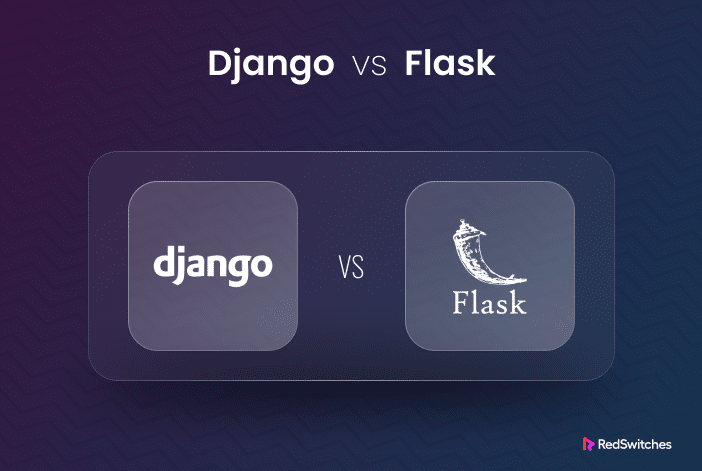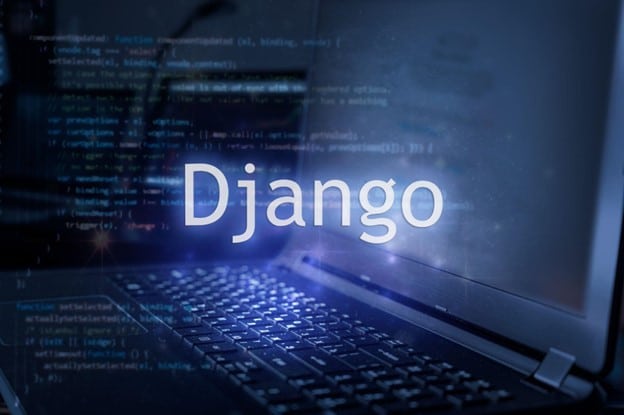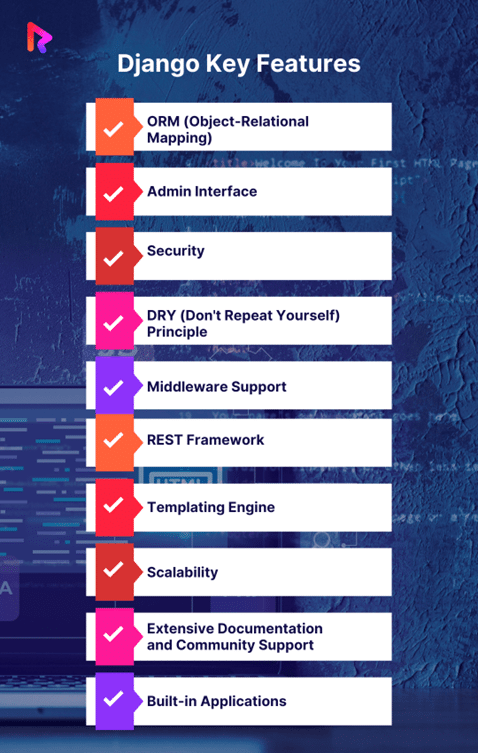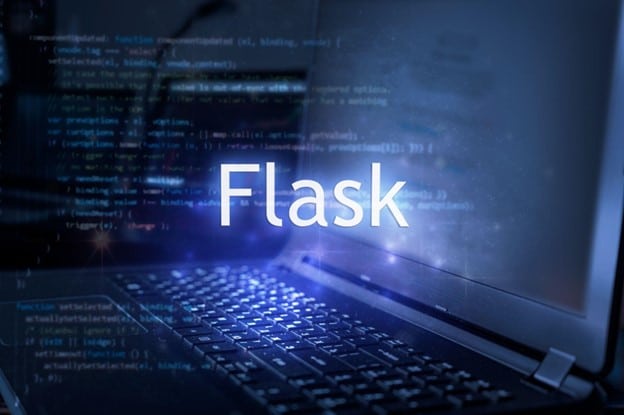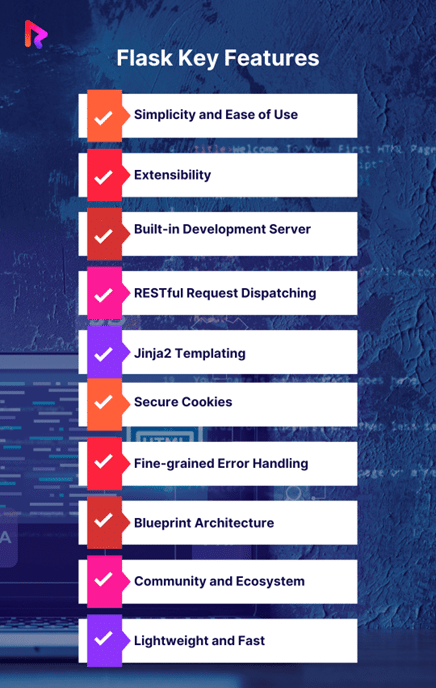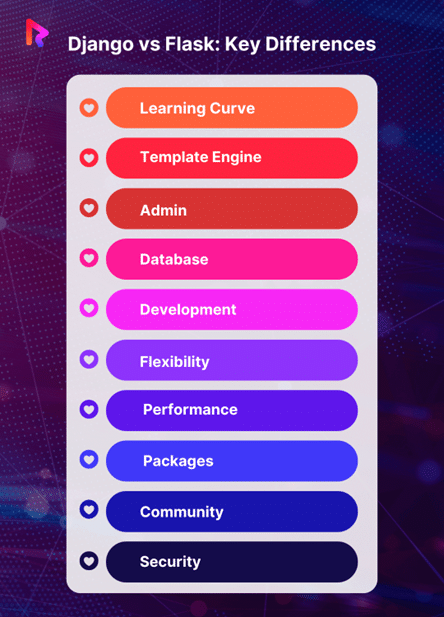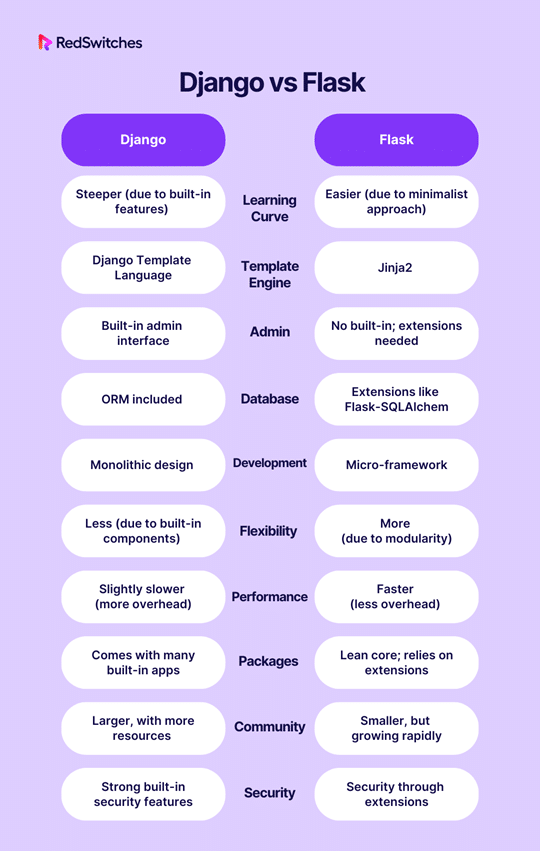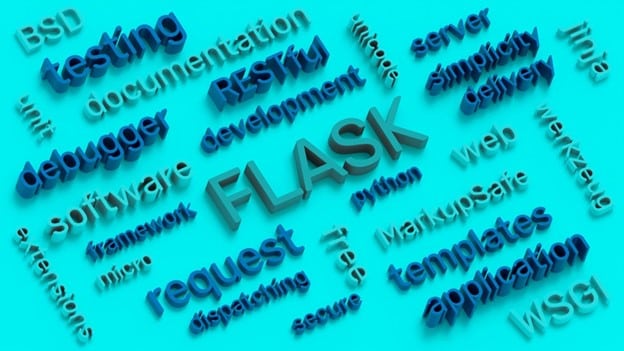In today’s tech-driven world, picking the right web framework for your project can significantly dictate its success. While many options are available, both Python frameworks, Flask and Django, are prominent. According to Statista, approximately 12.16% of developers use Flask, and 11.47% use Django as their go-to web framework in 2024.
When given the choice between several web frameworks, many people struggle with deciding between Django or Flask: which is better. This blog will review the pros and cons, key features, and differences to help you compare Django vs Flask. Let’s compare to determine which web framework, Flask or Django, best fits you.
Table of Contents
- What is Python?
- What Is Django?
- What Is Flask?
- Flask vs Django: Key Differences
- When to Use Flask?
- When to Use Django?
- Should You Use Flask or Django? – Final Thoughts
- FAQs
Credits: Pexels
What is Python?
Python is a one-of-a-kind, high-level programming language that stands out for its versatility, readability, and ease of use. It was developed in the 1980s and has since become a prominent name in the development world. It’s been employed for web development, artificial intelligence, data analysis, and more, mainly due to its extensive standard library and supportive community.
What is a Python framework?
In web development, a framework offers a structured foundation for developers to build sites or applications. A Python framework is a pre-written set of modules or packages, enabling developers to avoid reinventing the wheel and accelerating the coding process. Through a framework, developers can uphold the modularity of applications and follow the DRY (Don’t Repeat Yourself) principle, thereby improving code maintainability.
Before comparing Django vs Flask, we must discuss the individual definitions, features, and pros and cons.
Let’s Begin!
What Is Django?
Credits: Shutterstock
Django, often labeled ‘the web framework for perfectionists with deadlines,’ is a high-level Python web framework focused on accelerated development and sophisticated, pragmatic design. Established in the mid-2000s, countless developers have used Django to produce robust and scalable applications.
Django: Pros vs Cons
Weighing the pros and cons of Django is a great way to determine whether it is a suitable choice for you. Below are the pros and cons of the web framework:
Pros
- Batteries-included Philosophy: Django adopts a ‘battery-included’ philosophy to deliver comprehensive tools and features. Some built-in features include an ORM (Object-Relational Mapping), authentication mechanisms, and an admin interface. This enables developers to minimize the need for third-party tools or libraries for most tasks.
- Admin Interface: Django’s automatic, built-in admin interface is among its standout features, allowing efficient content management without the hassle of building the interface from scratch.
- Highly Scalable: Key players like Pinterest and Instagram use Django. It’s created to handle high traffic and can be conveniently scaled to fit the demands of large-scale applications.
- Secure: Django strongly emphasizes security and includes built-in protection against attacks like SQL injection, XSS, and CSRF.
- Robust Documentation: Django’s extensive documentation is considered one of the best in the industry, making it simpler for novices to pick up and for seasoned developers to reference.
Cons
- Monolithic: While Django’s ‘batteries-included’ philosophy has its benefits, it also has several drawbacks. Django can feel too heavy for micro-projects or services.
- Learning Curve: While powerful, Django has a steeper learning curve, especially for individuals new to the web development realm.
- Less Flexibility: Although Django’s ORM system is robust, it offers less flexibility than SQLAlchemy (commonly used with Flask). Users seeking more control over database operations may find Django’s ORM restrictive.
Django Key Features
Below are the top features of Django:
ORM (Object-Relational Mapping)
Django has an integrated ORM, enabling developers to define their database structure as Python classes. The ORM then handles the development of database tables and offers a high-level, Pythonic way to interact with databases. It supports several databases, including MySQL, PostgreSQL, SQLite, and Oracle.
Admin Interface
One of the most promising features of Django is its automatically generated admin interface. Once you define your data models, Django can curate a professional, production-ready administrative interface – a significant feature for developers and site admins.
Security
Django places a strong emphasis on security. It offers built-in protection against common security threats, including SQL injection, clickjacking, cross-site scripting, and request forgery. Passwords are stored securely using a hash algorithm, and the framework receives updates regularly to tackle any new vulnerabilities.
DRY (Don’t Repeat Yourself) Principle
Django follows the DRY principle, promoting the reusability of code. Instead of writing the same code in several places, developers can streamline their work by defining behaviors or configurations in one place and then using them throughout the project.
Middleware Support
Django’s middleware classes enable the request and response process globally before reaching the view. This feature offers functionalities like CSRF protection, authentication, content compression, and more to be implemented modularly.
REST Framework
While Django is great for building traditional web applications, the Django REST Framework (often called DRF) incorporates powerful, flexible tools for curating web APIs. This makes producing a back end that can serve mobile apps, single-page applications (SPAs), and other front-end technologies easier.
Templating Engine
Django’s templating engine enables developers to define the output layout using placeholders for data. This separation of logic from presentation makes managing and designing user interfaces easier.
Scalability
Several high-traffic websites, like Instagram and Pinterest, use Django, serving as a testament to its scalability. With proper architecture and caching, Django can tackle millions of users.
Extensive Documentation and Community Support
Django’s extensive documentation is a godsend for both novice and experienced developers. The large and active community ensures that developers can access forums, tutorials, third-party packages, and support that can further streamline development.
Built-in Applications
Django integrates with several built-in apps that can be quickly dropped into any project. Some examples include authentication apps (with user accounts, roles, and permissions), sitemaps, content admin, and more.
Are you wondering which is better, Python or PHP? Read our comprehensive guide, ‘Python Vs PHP: 14 Compelling Arguments To Help You Decide.’
Companies Using Django
Many prominent companies and organizations use Django for their sites and applications, leveraging its powerful features and scalability. Some well-known names include:
- Instagram: One of the most popular photo-sharing apps started with Django and has stuck with it even after its immense growth.
- The Washington Post: This renowned newspaper uses Django to offer its digital audience timely news updates.
- Mozilla: The organization behind the popular Firefox browser leverages Django for several parts of its web infrastructure.
- Eventbrite: The event management and ticketing site trusts Django to manage its vast number of event listings and ticketing functions.
- Disqus: The widely-used commenting plugin, embedded in many sites, is built using Django.
- NASA: Django powers some of the applications and tools used by the U.S. space agency.
- National Geographic: The site offering stunning visuals and rich content about our planet is powered by Django.
- Bitbucket: The platform started with Django before migrating to other technologies.
- Prezi: The presentation tool uses Django for its web functionalities.
Also Read: Frameworks: Django vs Laravel – A Comprehensive Comparison in Web Development
What Is Flask?
Credits: Shutterstock
Flask is a lightweight Python web framework that simplifies web application development. It offers the essentials for building web-based applications. It can also be described as a micro web framework written in Python. ‘Micro’ doesn’t mean that your whole web application has to fit into a single Python file, though it can.
Instead, it signifies Flask’s minimalistic approach – it doesn’t force specific tools or libraries on users. This empowers developers to govern how to implement things, making Flask lightweight and easily adaptable.
Flask: Pros vs Cons
Credits: Shutterstock
Considering the pros and cons of Flask is an excellent method of determining whether it is a suitable choice for you. Below are the pros and cons of the web framework:
Pros
- Simplicity and Flexibility: Flask’s ‘micro’ nature ensures it doesn’t have an extensive list of useless features you might never use. This makes it straightforward for beginners to get started with. Flask’s flexibility lets developers pick their tools, making it ideal for small and large applications.
- Extensions: Flask’s design focus is on extensibility. If you want a specific functionality, there’s likely an extension available for it. This modular approach ensures you only include what you require, keeping your project lightweight.
- Development Speed: The simplicity of Flask enables rapid development. It allows developers to transition from an idea to a prototype.
- RESTful request dispatching: Flask’s restful request dispatching system makes it excellent for building RESTful APIs, further enhancing its versatility.
- Community Support: Flask’s growth has cultivated a large community. This has resulted in a wealth of guides, and third-party tools available to help at every step.
Cons
- Scalability Concerns: While Flask is ideal for small to medium-sized applications, it might not be the best choice for extensive applications or real-time web apps. Although Flask can’t handle it, it may demand more manual optimization and configurations.
- Lack of Conventions: Flask’s flexibility can be a double-edged sword. The lack of a specific way to structure your application means decisions on the best practices are up to you. This can be overwhelming for novices.
- Dependency on Extensions: Flask relies heavily on extensions for more advanced features. You’ll often need to rely on third-party solutions, which may or may not have the same stability and security level as Flask.
- Performance Overhead: While Flask is lightweight, it might not be as good in performance as some other web frameworks in specific scenarios, especially when tackling multiple simultaneous connections.
Looking to learn more about the different databases? Read our informative blog, ‘Navigating the Linux Database Landscape: A Deep Dive into PostgreSQL, MySQL, and Beyond.’
Flask Key Features
Below are the top essential features of Flask:
Simplicity and Ease of Use
Flask boasts a minimalistic approach, ensuring that even novices can easily understand its concepts. It allows one to have a basic web app running with only a few lines of code. Its intuitive structure and syntax make Flask rank high among the most user-friendly frameworks.
Extensibility
While Flask is lightweight, it features incredible extensibility. Developers can incorporate various extensions in the ecosystem, enhancing the framework’s functionality to meet specific requirements, including database integration, form validation, or authentication.
Built-in Development Server
Flask comes with a development server, so you are freed from the hassle of setting up an external server when you start building with Flask. This built-in server is suitable for development, testing, and debugging.
RESTful Request Dispatching
Flask makes it hassle-free to build RESTful services. With its simple route decorators, developers can easily define routes for their applications and build APIs that follow RESTful principles.
Jinja2 Templating
Flask uses the powerful Jinja2 templating engine. This enables developers to build dynamic web pages easily using Python-like expressions. The smooth integration of Jinja2 ensures that web templates are both flexible and easy to work with.
Secure Cookies
Flask supports secure cookies, allowing client-side sessions to remain secure and encrypted. This ensures data integrity and confidentiality, making it difficult for attackers to tamper with session data.
Fine-grained Error Handling
Flask provides a powerful and customizable error-handling mechanism. Developers can define custom error pages or responses, ensuring users get meaningful feedback when application exceptions or errors occur.
Blueprint Architecture
Flask’s Blueprint feature is an incredible feature for larger applications. Blueprints allow developers to organize their projects better, promoting modular and reusable code. They enable the structuring of applications in a way that scales with size and complexity.
Community and Ecosystem
One of Flask’s undeniable strengths is its community. The extensive documentation and numerous tutorials, forums, and blogs ensure developers have a wide range of resources. The active community also allows Flask to continue to evolve and improve.
Lightweight and Fast
Being a micro framework, Flask doesn’t come bundled with libraries and tools that a developer might not need. Flask applications are lightweight, ensuring speedy performance and accelerated load times.
Companies Using Flask
Many renowned companies and developers use Flask for various web projects ranging from simple web pages to complex APIs. Below are some well-known companies and projects that have used Flask:
- Netflix: Netflix is among the most prominent companies to use Flask for several purposes, including its backend tools and platforms.
- Airbnb: The vacation rental company has used Flask to build internal tools. Their ‘Airflow’ platform, a tool for orchestrating complex computational workflows and data processing pipelines, was initially built with Flask.
- Reddit: The website has used Flask for certain services, especially for some of its internal applications and utilities.
- Uber: The ride-sharing app has used Flask for some parts of its massive system, especially some services requiring rapid development and iteration.
- Lyft: Like Uber, Lyft has also used Flask for various services within its infrastructure.
- Zillow: The real-estate site has used Flask for some of its server-side services, benefiting from its simplicity and the power of Python to process large datasets.
- LinkedIn: The platform has employed Flask for some experimentation platforms.
- Pinterest: The image-sharing service has used Flask for API endpoints and internal applications.
- Maildrop: A renowned temporary email service, uses Flask as part of its backend.
Also Read An Introduction To Database: Types, Understanding DBMS & More.
Flask vs Django: Key Differences
Django and Flask are two of the most renowned Python frameworks that frequently come into comparison. Both have strengths and use cases, making the ‘Django vs Flask’ debate important. By understanding the difference between Flask and Django, individuals can decide which is best for their use case. Below are the key differences between the two.
Learning Curve
Below is a comparison of the difference between Django vs Flask in terms of the learning curve:
Django
Django follows the ‘batteries-included’ philosophy. It comes with a wide range of built-in tools and functionalities. This might seem overwhelming to beginners due to the wide array of components, making its learning curve steeper than Flask.
Flask
Flask is a ‘micro’ framework. Its minimalistic and modular approach allows developers to add only necessary components. This simplicity makes it easier to understand for newcomers, offering a gentler learning curve compared to Django.
Template Engine
Below is a comparison of the difference between Django vs Flask in terms of template engine:
Django
Django integrates with its template engine, which is both powerful and flexible. It’s designed to be easily readable and restricts the use of Python code. This helps maintain a clear separation between the presentation and logic layers.
Flask
Flask uses the Jinja2 template engine by default. Jinja2 is expressive. It allows developers to embed Python-like expressions and control statements in the templates. This offers excellent flexibility and can be used outside Flask, making it versatile.
Admin
Below is a comparison of the difference between Django vs Flask in terms of the admin:
Django
One of Django’s standout features is its automatically generated admin interface. This interface offers developers and site administrators a comprehensive set of tools to manage the content and users of their website without having to write additional code.
Flask
Flask does not come with a built-in admin interface. If developers require one, they might need to integrate third-party tools like Flask-Admin. While this means developers have to go through an additional setup, it allows for more customization according to the project’s needs.
Database
Below is a comparison of the difference between Django vs Flask in terms of the database:
Django
As stated above, Django includes an Object-Relational Mapping (ORM) system, allowing developers to define their database schema using Python classes. It supports various databases and has a built-in migration system, simplifying database schema changes over time.
Flask
Although Flask does not have a built-in ORM, it can be easily integrated with SQLAlchemy or other database tools, offering developers flexibility in picking their database system and design pattern. This modular approach means that the database aspect of a Flask app can be as comprehensive or as lightweight as needed.
Development
Below is a comparison of the difference between Django vs Flask in terms of development:
Django
Django follows the Model-View-Controller (MVC) pattern. This encourages a specific structure in app development. Its integrated tools, like the authentication system, form handling, and more, help accelerate development for more extensive and feature-rich applications.
Flask
Flask offers immense freedom in terms of project structure. Developers aren’t bound to a specific pattern, allowing for more flexibility. While this can be liberating, it also means that best practices might not be as strictly enforced. This makes Flask better suited for small to medium-sized applications or when rapid prototyping is desired.
Flexibility
Below is a comparison of the difference between Django vs Flask in terms of flexibility:
Django
Django adopts a ‘batteries-included’ approach. It provides much built-in functionality, making it less flexible than Flask. The idea behind Django is to offer a holistic framework where most of the important features are already integrated.
Flask
Flask allows developers to choose how they want to implement things. You can start with the basics and then add extensions as needed. This modular approach provides a higher degree of flexibility compared to Django.
Performance
Below is a comparison of the difference between Django vs Flask in terms of performance:
Django
While Django’s monolithic structure sometimes leads to overhead, which might impact performance, this is often negligible for many web applications. It’s designed to help developers build applications quickly without reinventing the wheel.
Flask
While Flask tends to be lightweight and might offer better performance, this can change as you add more extensions. Yet, when comparing Flask vs Django performance, Flask gives developers more control over performance optimizations.
Packages
Below is a comparison of the difference between Django vs Flask in terms of the packages:
Django
Django features a robust ORM, an admin interface, authentication, and many more built-in features. Users may not need as many external packages as they would with Flask.
Flask
Flask comes with fewer features. Users must rely on external packages or Flask extensions to add functionalities like database integration or authentication. This approach can be both an advantage (customizability) and a disadvantage (potential for package conflicts).
Community
Below is a comparison of the difference between Django vs Flask in terms of the community:
Django
Django has a massive and active community. This extensive community support translates to regular updates, plenty of third-party packages, extensive documentation, and many tutorials and resources.
Flask
Although smaller than Django’s, Flask’s powerful community attracts new developers due to its flexibility and simplicity.
Security
Below is a comparison of the difference between Django vs Flask in terms of security:
Django
Django takes security seriously. It offers several built-in features to handle common security threats like CSRF, SQL injection, and XSS. The Django community is also quick to address any new vulnerabilities.
Flask
Flask provides the essential tools to build secure web applications, but it’s reliant on the developer to implement them accurately. Since Flask is minimalistic, some automatic security features in Django might demand manual setup in Flask.
So summarize, here is a quick summary of all the differences between Django vs Flask:
Also Read: What Is Schema In Database? Breakdown of 9 Key Aspects.
Now that we have discussed every significant difference between Django and Flask let’s explore when to use both web frameworks.
When to Use Flask?
Credits: Shutterstock
Here are situations where Flask could be the best choice:
- Prototyping and Small Applications: If you’re building a prototype or an MVP (minimum viable product), Flask’s straightforward setup can streamline the process of getting your application off the ground. Its lean nature ensures no unnecessary overhead, making it suitable for modest apps.
- Learning and Teaching: Flask is often a top contender for educational purposes due to its simplicity. If you’re new to web development or teaching web concepts, Flask allows you to focus on the fundamentals without the issues of a vast framework.
- Customized Solutions: Flask offers enhanced flexibility, allowing developers to choose tools and components. If your project has unique requirements that don’t fit the typical mold of web applications, Flask allows you to build as you see fit.
- Microservices Architecture: Flask’s lightweight nature can benefit projects with microservices architecture. Each service can be a separate Flask app, ensuring the system remains modular and scalable.
When to Use Django?
Let’s delve into scenarios where Django could be your best bet:
- Large-scale Applications: Django’s ORM, middleware support, and built-in admin interface make it best for more extensive applications where these features can save considerable development time. Django’s structure might serve you well if your application grows in complexity.
- Standard Web Applications: Django has many built-in features like authentication, sitemaps, RSS feeds, etc. If you’re building a standard web application that requires such features, using Django can reduce the need for third-party packages or reinvent the wheel.
- Integrated Toolset: Django’s ‘batteries-included’ philosophy offers a holistic experience. Django is ideal if you prefer a framework that offers an integrated set of tools instead of piecing together components.
- Security Concerns: Django prioritizes security, protecting against CSRF attacks, SQL injections, and more. If your application handles sensitive data or you prioritize security, Django’s built-in security features can be a boon.
- Community and Packages: Django has a massive community, which means a wealth of third-party packages, extensive documentation, and many tutorials. This support can be invaluable, especially if you encounter uncommon issues or require specialized packages.
Should You Use Flask or Django? – Final Thoughts
Django and Flask have emerged as powerful contenders in the top Python web frameworks list. While Django provides a robust, all-inclusive experience with its ‘batteries-included’ approach, Flask empowers developers to produce flexible and minimalistic applications.
When comparing Django vs Flask and determining which to choose, it is critical to consider factors like your project’s requirements, familiarity with the frameworks, and the specific issues you aim to address.
A trustworthy and reliable hosting environment is crucial for optimal performance, regardless of your choice. If you’re searching for high-quality hosting solutions to support Django and Flask applications, consider exploring RedSwitches.
With our expertise, you can ensure your Python-based web application runs smoothly and efficiently, regardless of your chosen framework. So what are you waiting for? Contact us today for more information on our services.
FAQs
Q. Is Flask better than Django?
Flask and Django cater to varying needs. While Flask offers flexibility and modularity, Django provides an all-in-one solution. Which choice is better depends on the specific requirements of your project and the Django vs Flask paradigm you align with.
Q. Does Netflix use Flask?
Yes, Netflix uses Flask for specific microservices and backend tools, which shows that Flask is capable of large-scale production environments.
Q. Can Flask replace Django?
Flask and Django serve different purposes. While Flask offers more flexibility for custom solutions, Django offers an integrated framework. Flask can be an alternative in specific scenarios, but whether it can replace Django depends on the specific needs of your project and where it stands in the Django vs Flask debate.
Q. What are the main differences between Flask and Django?
Flask is a micro web framework, providing simplicity and flexibility for small to medium web applications, while Django is a full-stack web framework with a more comprehensive set of features for larger, complex applications.
Q. Should I start with Flask or Django for web development?
If you are new to web development, Flask might be a good starting point due to its minimalistic approach, whereas Django, with its all-inclusive nature, is better suited for more experienced developers or larger projects.
Q. What are the advantages of using Django over Flask?
Django offers a built-in admin interface, an ORM for database interaction, and a batteries-included approach, making it more suitable for rapid development and large-scale applications compared to Flask.
Q. Are there any drawbacks to using Flask and Django?
While Flask provides more flexibility, it lacks certain built-in features and components that Django offers. On the other hand, Django may appear complex and cumbersome for smaller projects compared to Flask.
Q. Can I use both Flask and Django in the same web application?
Yes, it’s possible to integrate Flask and Django within the same project by leveraging their strengths for different parts of your web application, but it may introduce additional complexity in the development process.
Q. Is Flask easier to use than Django?
Flask is known for its simplicity and minimalistic design, making it easier for beginners and smaller projects, while Django, with its extensive features, may have a steeper learning curve but offers more out-of-the-box functionality.
Q. Which web framework should I choose, Flask or Django?
The choice between Flask and Django depends on the specific requirements of your project. Flask is great for lightweight, customizable applications, whereas Django excels in managing complex, feature-rich projects with less effort.
Q. Can I develop web applications without using a framework like Flask or Django?
While it’s possible to build web applications from scratch without a framework, using Flask or Django can significantly streamline the development process, handle common tasks, and provide a structured approach to web development.
Q. How does Django compare to Flask in terms of popularity amongst Python developers?
Django is generally more popular among Python developers due to its comprehensive features and strong community support, while Flask, with its minimalist approach, has a smaller but dedicated following within the Python development community.
Q. Can I use Jinja2 with both Flask and Django?
Yes, both Flask and Django support the Jinja2 templating engine, enabling developers to create dynamic and responsive web applications without constraints on their choice of web framework.
